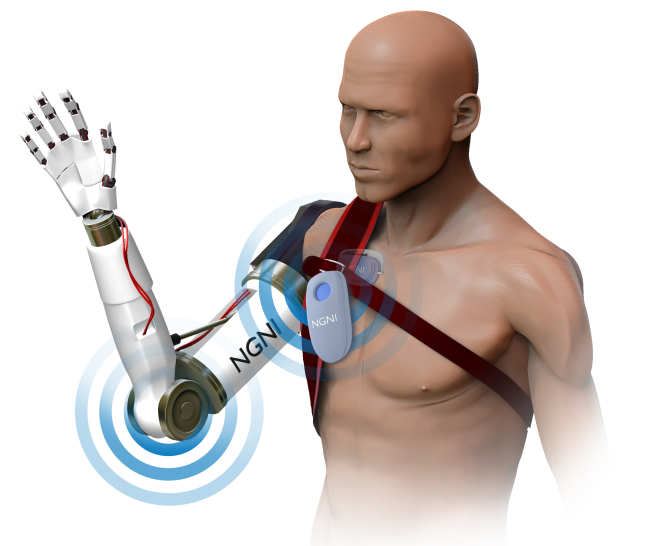Completed Project (2015-2018)
Research Team: Ian Williams, Adrien Rapeaux, Timothy Constandinou
Collaborators: Kianoush Nazarpour (Newcastle), Francisco Sepulveda (Essex), Luidi Jiang (Southampton), Ed Chadwick (Keele), Paul Steenson and Dr Rory J O'Conner (Leeds)
Funding: Engineering and Physical Sciences Research Council (EPSRC) EP/M025977/1
An artificial arm, or prosthesis, is an example of technology that can be used to help somebody perform essential activities of daily living after a serious injury that results in the loss of their arm. Such activities might include eating, washing, opening doors, or shaking hands with a friend. Many artificial arms on the market these days are highly sophisticated, offering individual finger movement, and even movement of segments within a finger, that resemble the natural arm and hand.

These prosthetic arms are often controlled by sensing the contractions in the muscles of the remaining arm to which the prosthesis is attached, allowing the user to operate the arm by flexing their muscles. However, one key aspect of artificial arms that is currently missing is the sense of feedback. In other words, the user does not know where the arm is or how wide open the hand is without looking at it, and if a delicate object is picked up, there is no sense of how hard it is being gripped. This leads to slow and awkward use of the artificial arm and prevents its use from becoming truly natural.
The goal of this project is to develop technologies that will enable the next generation of assistive devices to provide truly natural control through enhanced sensory feedback. Our long-term vision is for artificial arms that provide the user with a sense of feedback that recreates the natural feedback associated with a real arm.
To enable this level of feedback, we must meet two clear objectives: to generate artificial signals that mimic those of the natural arm and hand, and to provide a means of delivering those signals to the nervous system of a prosthesis user.
These objectives will be achieved by: building new fingertip sensors to give the prosthesis a realistic sense of touch, including pressure, shear and temperature; developing a 'virtual hand' that mimics the nerve impulses that would be produced by a real hand, giving the user a sense of position of an artificial hand; and designing electrodes and a stimulation system that can deliver the simulated nerve impulses directly to the individual's nervous system.
Publications
2022
- A. Rapeaux, O. Syed, E. Cuttaz, C. Chapman, R. Green, and T. G. Constandinou, “Preparation of rat sciatic nerve for ex vivo neurophysiology,” Journal of Visualised Experiments (JoVE), 2022. doi: https://doi.org/10.3791/63838
- A. Rapeaux and T. G. Constandinou, “HFAC dose repetition and accumulation leads to progressively longer block carryover effect in rat sciatic nerve,” Frontiers in Neuroscience, vol. 16, 2022. doi: https://doi.org/10.3389%2Ffnins.2022.852166
2021
- F. Del Bono, A. Rapeaux, D. Demarchi, and T. G. Constandinou, “Translating node of ranvier currents to extraneural electrical fields: a flexible FEM modeling approach,” in 2021 43rd Annual International Conference of the IEEE Engineering in Medicine & Biology Society (EMBC), IEEE, 2021. doi: https://doi.org/10.1109/EMBC46164.2021.9629677
2020
- I. Williams, E. Brunton, A. Rapeaux, Y. Liu, S. Luan, K. Nazarpour, and T. G. Constandinou, “SenseBack - an implantable system for bidirectional neural interfacing,” IEEE Transactions on Biomedical Circuits and Systems, vol. 14, no. 5, pp. 1079–1087, 2020. doi: https://doi.org/10.1109/TBCAS.2020.3022839
- A. Rapeaux and T. G. Constandinou, “An HFAC block-capable and module-extendable 4-channel stimulator for acute neurophysiology,” Journal of Neural Engineering, vol. 17, p. 046013, Jul 2020. doi: https://doi.org/10.1088/1741-2552/ab947a
2019
- I. Williams, A. Rapeaux, J. Pearson, K. Nazarpour, E. Brunton, S. Luan, Y. Liu, and T. G. Constandinou, “SenseBack – implant considerations for an implantable neural stimulation and recording device,” in IEEE Biomedical Circuits and Systems (BioCAS) Conference, 2019. doi: https://doi.org/10.1109/BIOCAS.2019.8919046
2018
- A. Rapeaux, E. Brunton, K. Nazarpour, and T. G. Constandinou, “Preliminary study of time to recovery of rat sciatic nerve from high frequency alternating current nerve block,” in 40th International Conference of the IEEE Engineering in Medicine and Biology Society (EMBC), 2018. doi: https://doi.org/10.1109/EMBC.2018.8512832
2016
- I. Williams, A. Rapeaux, Y. Liu, S. Luan, and T. G. Constandinou, “A 32-channel bidirectional neural/EMG interface with on-chip spike detection for sensorimotor feedback,” in IEEE Biomedical Circuits and Systems (BioCAS) Conference, pp. 528–531, 2016. doi: https://doi.org/10.1109/BioCAS.2016.7833848